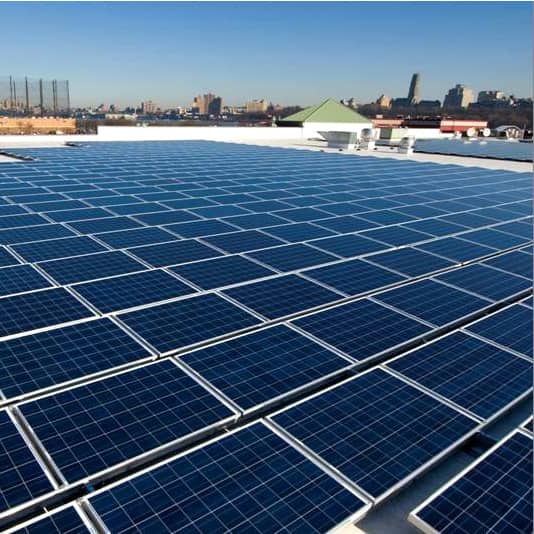 Within a decade, more than 35 million buildings may be generating their own solar electricity (without subsidies) at prices lower than their utility offers, sufficient to power almost 10% of the country, according to a new report.
Within a decade, more than 35 million buildings may be generating their own solar electricity (without subsidies) at prices lower than their utility offers, sufficient to power almost 10% of the country, according to a new report.
The report, released by the Institute for Local Self-Reliance (ILSR), warns that despite this opportunity, utilities, regulators and policymakers are still largely unprepared for the surge of local solar power.
In Minnesota, for example, the state's largest utility expects just 20 MW of new solar power in the next 13 years, according to its draft filing with the Public Utility Commission.
But within 10 years, ‘unsubsidized solar electricity will be so inexpensive that 200 times more solar (over 4,000 MW) could be installed on the rooftops of Minnesota homes and businesses, providing lower cost electricity than from the utility,’ says report author John Farrell, director of ILSR's Democratic Energy program.
Overall, a ‘solar revolution’ that has, thus far, been largely confined to states with generous sunshine (California), high electricity prices (New Jersey) or both (Hawaii) will spread rapidly in the coming years, the ILSR says. Utilities in unexpected states, such as Tennessee, Wisconsin and Nebraska, will face enormous competition from inexpensive rooftop solar power by 2022.
Many utilities and state regulatory commissions are finding the value in solar and realizing that perceived barriers are not as large as they had feared. Austin Energy, a Texas municipal utility, now pays a non-subsidy premium for solar because it helps the utility offset expensive peak power purchases, the report notes. In Hawaii, regulators have amended archaic limits to match renewable technology.
California grid legislators, meanwhile, have increased the amount of solar power that is allowed to use net metering to offset on-site electricity use. Colorado and Vermont have capped costs and streamlined solar permitting.
With a solar market driven by cheaper-than-electricity prices, Hawaii's electricity system may hint at the forthcoming paradigm change, according to the report.
One of the state's public utility commissioners notes that utilities need to transition from being grid dominators to facilitators, and from being inflexible to being flexible. They will need to switch from a reliance on utility-controlled, large, centralized coal and nuclear power plants to a nimble mix of flexible energy sources, such as energy storage, demand response or natural gas.
Already, the state is one of 14 states with local or state-based CLEAN contract (i.e., feed-in tariff) policies that dramatically simplify the process of going solar for residential and other electric customers.
With the cost of solar falling rapidly and local solar challenging utility prices nationwide, ILSR's report suggests that utilities will need to accommodate a grassroots movement toward local, affordable energy generation.
‘There will be more change in the next 10 years than utilities have faced in the last 100,’ says Farrell. ‘And they had best get ready.’
Status and challenges
Currently, 27 utilities in the U.S. have electricity rates high enough for commercial solar systems installed at $9/W to be competitive with retail electricity rates, according to the report. Among these are remote utilities in Hawaii and Alaska that often use imported diesel or oil as a power generation source.
‘The need for solar cost reductions is even more apparent when focused solely on larger utilities – those serving at least 10% of a state's commercial demand,’ the report adds. ‘Of these 101 large utilities nationwide, solar is competitive without subsidies in only five, three in Hawaii and two in New York, at a price higher than $4 per watt.’
As prices for solar continue to fall, federal incentives – to the tune of approximately $3 billion annually – are helping to drive installations. However, according to the report, these incentives present significant shortcomings in their current form.
In addition to posing a budgetary impact, federal solar incentives are also ‘inequitably applied,’ the report says. By 2016, if the incentives are applied in their current form and under likely 2016 solar pricing conditions, some projects will suffer, while others might unfairly benefit.
‘Solar projects in the Northwest or Midwest might be able to flip a project from unprofitable to profitable with the federal credit, while solar installers in California and Hawaii would be unnecessarily padding an already rich bottom line with taxpayer dollars,’ the report explains.
Finally, in 2017, the federal incentive is scheduled to be reduced from 30% to 10% (or eliminated altogether) – which the ILSR says will create long-term problems in areas where solar was less cost-effective.
‘The guiding principle should be to continue the enormous strides toward democratizing the electricity system by maintaining the growth of distributed solar, but also not offering unnecessarily high incentives in those parts of the country that no longer need them,’ the report says.
In order to reduce all three of these incentive problems, the ILSR recommends a more gradual phaseout, linking market performance to incentive rate, and factoring in local solar resources. This system, the organization says, would allow less-sunny regions to avoid being disproportionately affected when incentives are reduced.
The full report is available here.
Photo credit: Kimco Realty

